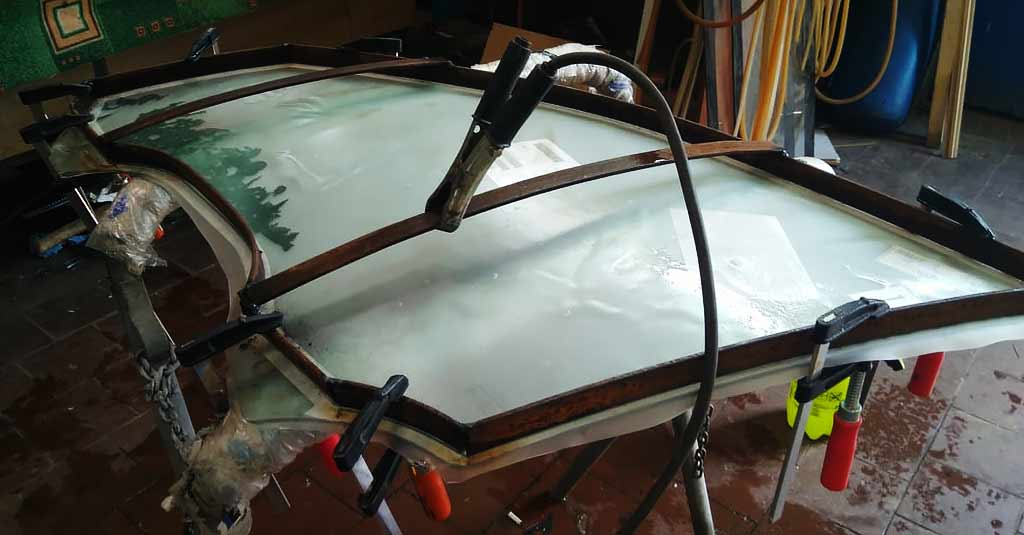The film is mandatorily applied to our products in production from the outside and inside. On the outside, the film is necessary to prevent the harmful effects of UV light on the electrochromic organic polymer, and protects it from premature degradation and destruction. The antispall protective film is also glued to the glass from the interior side. It is necessary to protect people inside the car from shards of glass in case of an accident. Our glass is made of "raw" or chemically hardened glass and can break up into small and sharp fragments in the event of destruction. The installed film is an integral part of the product, its removal is strictly forbidden. If the protective film fails, please contact your nearest distributor for advice on replacing the film.
If the glass is produced in FilmLess variant then only antispall protective film at the interior side of the glass is used.
Commercially available films with which flat glass can be bonded are only films with PDLC technology. But it should be taken into account that such a film can change its state from transparent to matted, the film is controlled by AC voltage up to 110V, such a film can not be glued to bent glass, the film has a high haze level. All other smart glass technologies, including organic polymeric electrochrome, can only work after encapsulation inside the glass unit.
The equipment is a design specifically designed for each car model and includes: 3D glass model, glass prayer molds, paintwork, film clippings and, of course, the usual 2D drawings.

Glass production from scratch can take up to 3 months due to the many processes involved, especially for glass models that are not available in our library. To begin with, you need to take the necessary dimensions, spatial scanning of the original glass, production of drawings and tooling. Company Octoglass aspires to become the enterprise of a full cycle, but while many stages of manufacture are tied on attraction of the foreign companies, the end of each of cycles is connected with possibilities of each concrete enterprise, features of logistics and other factors. Production of the kits, which are already present in the library and which we have already produced takes up to two months, because we already have the necessary drawings, sizes and tooling. For the hottest models we have warehouse program that allows to receive a set of glass just in one day. For warm models we have raw glass warehouse prohram that allows 1 week shipping of the glass.
Our glass products are controlled by special controllers. The controllers are supplied complete with electrochromic glass. Each of the controllers is individually adjusted to the complete glass. We do not recommend using controllers from other orders.
Since the condition of the tinted glass is maintained by applying voltage to it, when the voltage source is switched off, the charge inside the electrochromic glass is gradually spent on leakage currents and a smooth clarification process begins. If faster untinting is required, the Octoglass controller can be used, which terminates the electrochromic glass via a special circuit, providing an accelerated reaction of lightening. It is not recommended to use third-party controllers together with Octoglass glass. Do not use circuits with polarity reversal for accelerated glass scanning.
After completing the production process of the set from scratch, the customer can be provided with tooling if it is produced at his expense. As mentioned earlier, the tooling includes both 2D drawings, spatial models and a massive metal structure for glass molding. The client has the right to take it away, another thing is that it is not lightweight and small in size, and it will be difficult to find its application besides glass production.
We use organic electrochromic polymer to produce automotive glass using electrochromic technology. One of the features of using organic is the need for periodic relaxation procedure. During relaxation, parasitic effects are removed from the electrochromic system, which allows the glass to be used for many years. This procedure is embedded in Octoglass controllers and is performed automatically.
The same colours are available for vehicles as for architectural glass. However, we recommend using black glass as it does not distort the colour perception of the environment.
Yes, our controllers support firmware updates. And from time to time we release a firmware update for our controllers. However, the upgrade is possible only by the dealers.
Yes, the factory film on the glass can be replaced, but only qualified personnel can perform this operation. Furthermore, the use of poor quality film may lead to premature failure of the glass. To replace the film, contact the dealer from whom the glass was purchased.
When making glass we use only original films and coatings. In our work, we have come across the fact that even by purchasing the film from a proven supplier it is possible to obtain a product that does not meet the required characteristics. Therefore, it is not recommended to purchase and replace the protective films on glass yourself.
Electrochromic glass colouring and dissipation can be accelerated by applying high or reversible voltage to the glass. The thoughtless use of elevated or reversible voltage reduces the life of electrochromic glass by thousands of times. In Octoglass controllers, the accelerated toning and untoning modes are tuned to a specific auto glass pair, so their use does not affect the durability of electrochromic glass life.
This issue is solved quite simply, at least in Russia. Glass installed on a motor vehicle must meet technical regulations. In other words, it should have a light transmission value of at least 70% (for side glass) and at least 75% (for windshield). This answer was received, once again, directly from MIA of the Russian Federation.
It works but slower. We recommend to heat the interior of your car before usage of EC glass. More information ca be found here.